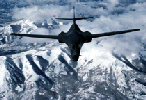







The B-1B is a multi-role, long-range bomber, capable of flying intercontinental missions without refueling, then penetrating present and predicted sophisticated enemy defenses. It can perform a variety of missions, including that of a conventional weapons carrier for theater operations.
The B-1B's electronic jamming equipment, infrared countermeasures, radar location and warning systems complement its low-radar cross-section and form an integrated defense system for the aircraft.
The swing-wing design and turbofan engines not only provide greater range and high speed at low levels but they also enhance the bomber's survivability. Wing sweep at the full-forward position allows a short takeoff roll and a fast base-escape profile for airfields under attack. Once airborne, the wings are positioned for maximum cruise distance or high-speed penetration.
The B-1B uses radar and inertial navigation equipment enabling aircrews to globally navigate, update mission profiles and target coordinates in-flight, and precision bomb without the need for ground based navigation aids. Included in the B-1B offensive avionics are modular electronics that allow maintenance personnel to precisely identify technical difficulties and replace avionics components in a fast, efficient manner on the ground.
The aircraft's AN/ALQ 161A defensive avionics is a comprehensive electronic counter-measures package that detects and counters enemy radar threats. It also has the capability to detect and counter missiles attacking from the rear. It defends the aircraft by applying the appropriate counter-measures, such as electronic jamming or dispensing expendable chaff and flares. Similar to the offensive avionics, the defensive suite has a re-programmable design that allows in-flight changes to be made to counter new or changing threats.
The B-1B represents a major upgrade in U.S. long-range capabilities over the aging B-52 -- the previous mainstay of the bomber fleet. Significant advantages include:
The first B-1B was delivered to the Air Force at Dyess Air Force Base, Texas, in June 1985, with initial operational capability on Oct. 1, 1986. The final B-1B was delivered May 2, 1988.
The B-1B holds several world records for speed, payload and distance. The National Aeronautic Association recognized the B-1B for completing one of the 10 most memorable record flights for 1994.
Specifications |
|
| Primary Function: | Long-range, multi-role, heavy bomber |
| Builder: | Rockwell International, North American Aircraft |
| Operations Air Frame and Integration: | Offensive avionics, Boeing Military Airplane; defensive avionics, AIL Division |
| Power Plant: | Four General Electric F-101-GE-102 turbofan engine with afterburner |
| Thrust: | 30,000-plus pounds (13,500-plus kilograms) with afterburner, per engine |
| Length: | 146 feet (44.5 meters) |
| Wingspan: | 137 feet (41.8 meters) extended forward, 79 feet (24.1 meters) swept aft |
| Height: | 34 feet (10.4 meters) |
| Weight: | Empty, approximately 190,000 pounds (86,183 kilograms) |
| Maximum Takeoff Weight: | 477,000 pounds (214,650 kilograms) |
| Speed: | 900-plus mph (Mach 1.2 at sea level) |
| Range: | Intercontinental, unrefueled |
| Ceiling: | Over 30,000 feet (9,000 meters) |
| Crew: | Four (aircraft commander, pilot, offensive systems officer and defensive systems officer) |
| Armament: | Up to 84 Mark 82 conventional 500-pound bombs and 30 CBU-87/89/97. Also can be reconfigured to carry a wide range of nuclear weapons |
| Date Deployed: | June 1985 |
| Unit Cost: | $200-plus million per aircraft |
| Inventory: | Active force, 50 (PAA) 84 (actual); ANG, 10 PAA (11 actual); Reserve , 0 |
